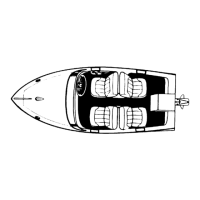CLOSED COOLING MODELS - 6B-1790-823225--1 1096
Closed Cooling Systems
With Coolant Flow Thru
Exhaust Manifolds
(Excluding Engines With
Serpentine Belt)
Maintaining Coolant Level
72520
a
Coolant Recovery Bottle
a - Fill Cap
Before starting engine each day, check to ensure that
coolant is visible in coolant recovery bottle.
If coolant is not visible, check fresh water section of
cooling system (including coolant recovery system)
for leaks and repair, as necessary. Refill fresh water
section with recommended coolant solution, as out-
lined under “Changing Coolant,” following.
If coolant is visible, start engine and run until it reach-
es normal operating temperature, then recheck cool-
ant level in coolant recovery bottle. Coolant level
MUST BE between the ADD and FULL marks (on
front of bottle).
!
WARNING
Allow engine to cool before removing pressure
cap, as sudden loss of pressure could cause hot
coolant to boil and discharge violently. After en-
gine has cooled, turn cap 1/4 turn to allow any
pressure to escape slowly, then push down and
turn cap all the way off.
If level is low, remove fill cap from coolant recovery
bottle and add required amount of coolant solution.
Use a 50/50 mixture of ethylene glycol antifreeze and
pure, soft water for coolant additions. If frequent addi-
tions of coolant are required, check fresh water sec-
tion for leaks.
IMPORTANT: ALCOHOL OR METHANOL BASE
ANTIFREEZE OR PLAIN WATER ARE NOT REC-
OMMENDED FOR USE IN COOLING SYSTEM AT
ANY TIME. In areas where ethylene glycol is not
available, and the possibility of freezing does not
exist, it is permissible to use a solution of rust in-
hibitor and pure, soft water (mixed to manufac-
turer’s recommendations).
Occasionally, check to ensure that coolant recovery
system is functioning properly by removing pressure
cap from heat exchanger and checking level. Coolant
level should be up to bottom of heat exchanger filler
neck. If low, examine entire fresh water section (es-
pecially coolant recovery system) for leaks and re-
pair, if necessary.
IMPORTANT: When reinstalling pressure cap, be
sure to tighten it until it contacts stops on filler
neck.
Pressure Cap Maintenance
Pressure cap is designed to maintain pressure in
fresh water section of closed cooling system once the
engine has attained normal operating temperature.
This raises the boiling point of the coolant, thereby in-
creasing the efficiency of the cooling system. To help
ensure proper operation, cap should be cleaned, in-
spected and pressure tested periodically as follows:
!
WARNING
Allow engine to cool before removing pressure
cap (in next step), as sudden loss of pressure
could cause hot coolant to boil and discharge vi-
olently. After engine has cooled, turn cap 1/4 turn
to allow any pressure to escape slowly, then
push down and turn cap all the way off.
1. Remove pressure cap from heat exchanger.
2. Wash cap with clean water to remove any
deposits or debris from sealing surfaces.
3. Inspect rubber seal on cap for cuts, cracks or
other signs of deterioration. If seal is damaged,
cap MUST BE replaced.
4. Inspect coolant recovery gasket for deterioration
and replace if bad.

